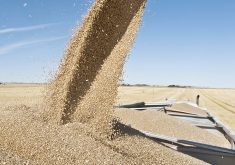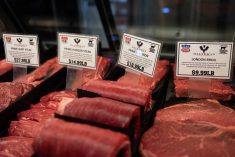U.S. checks suspicious cow
U.S. cash markets were in flux June 28 after the USDA announced June 25 that a second cow had tested positive for BSE in a preliminary screening test and was to be retested for confirmation. USDA said the animal did not enter the human food system.
In Canada last week, fed steers were down 75 cents per hundredweight, while fed heifers were $1 lower, but averages were still above $71, said Canfax.
Packers continue to be less than aggressive bidders because they own good supplies.
Read Also

Soybean market still figuring out implications of China-U.S. pact
Soybean futures had a muted reaction to the U.S. trade deal with China as the market tries to figure out the nuances of the deal.
Volume traded was up 31 percent from the week before at more than 21,600 head. Trade slowed at the end of the week, said Canfax.
Alberta prices June 24 were steers $68.25-$71 per cwt. live, $117-$119 railgrade and heifers were $71 live and $118 dressed.
Canfax said prices have been in the low $70s for five weeks and could be described as fragile.
Larger kills each week are helping to get more cattle through the pipeline but eventually the supply of market-ready cattle will surpass demand, Canfax said.
Canadian cutouts lost $1.50-$2 per cwt. last week in response to the drastic drop in U.S. cutouts the previous week. U.S. cutouts turned mixed last week with Choice down $1.37 US and Select up $1.10.
Canadian wholesale carcass values are steady to $2 Cdn lower, with the Montreal price at $140-$142 per cwt. and the Calgary market at $133-$136.
Large kills continue to keep plenty of product available for the domestic and export markets.
Auction mart volumes dip
Alberta auction market volumes were slightly lower with slightly more than 8,000 head trading, a drop of five percent.
Prices throughout the week were mostly steady to slightly lower.
Steers 400-500 lb. were off slightly, 500-600 lb. were down 50 cents, and 600-700 lb. saw little change.
Steers 700-800 lb. rose $1.25 while 800-900 lb. and heavier were 25-75 cents lower than the week before.
Heifers 400-800 lb. were down 50-75 cents, 800-900 lb. were $1.25 lower, and 900 lb. and heavier were unchanged.
D1, 2 cows were $1.25 lower and butcher bulls fell $2.50.
Canfax said feeder volumes will continue low until grass conditions become an issue.
If good moisture conditions continue, grass cattle are not expected to move until late August. Volatile prices will continue and will depend on the location and buyer depth of the day.
D1, 2 cows are expected to continue hovering in the mid $20s.
Stock bred cows in northern Alberta brought $200-$450 on light trade and no bred heifers were reported across the province.
Cow-calf pairs in southern Alberta were $625-$810 on limited trade and in central Alberta were $520-$950. Cow-calf pairs in northern Alberta were $375-$700.
Hogs and sheep
Cash prices for hogs in the U.S. increased about two percent over the week despite steady wholesale cut-out prices, said Manitoba Agriculture. The Iowa-Minnesota daily direct hog price (plant mean, 51-52 percent, lean carcass converted to live weight) increased from $60.49 US per cwt. on June 21 to $62.23 on June 23, then fell to $61.86 June 24.
It appears that some hog slaughtering plants have reduced slaughter due to poor margins and seasonally tight supplies.
Manitoba hog prices were estimated to be similar to the previous week’s estimated prices.
Ron Plain of the University of Missouri said the June 1 USDA hogs report came in a little more positive than he expected, but was close to the average of trade estimates.
The total number of hogs was up one percent, breeding herd down two percent and market herd up one percent.
Ontario Stockyards reported 2,248 sheep and lambs and 295 goats traded.
Light grain fed lambs sold barely steady, while heavy and plainer types traded $10-$15 cwt. lower.
Sheep and goats held steady.














